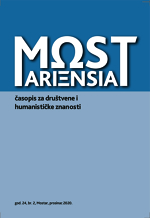HETEROGENA ETNIČKA STRUKTURA MAHALA KAO JEDNA OD PODLOGA UTVRĐIVANJU URBANE STRUKTURE GRADA
DIFFERENT ETHNIC STRUCTURE OF THE MAHALAS AS ONE OF THE BASES FOR ESTABLISHING THE URBAN STRUCTURE OF THE TOWN
Author(s): Borislav PuljićSubject(s): Cultural history, Social history, Rural and urban sociology, The Ottoman Empire, Sociology of Religion
Published by: Sveučilište u Mostaru i Institut društvenih znanosti Ivo Pilar, Zagreb
Keywords: Mahala; town; ethnic structure; Ottoman period; urban structure;
Summary/Abstract: It is a common belief in profession and science that oriental towns are segregated on ethnical principles. This opinion prevails also in connection with the towns of the Balkans that were shaped in the time of Ottoman dominance in that area. From the earliest times till today in the residential zones, Mahalas, of the oriental towns we have different ethnic or religious communities, even tribal groups, living seperately. The research presented in this paper on the example of the town of Mostar from the Ottoman period refutes this commonly accepted thesis. We suggest this be further investigated through more research accross Bosnia and Herzegovina. The thesis has been proved through the demographic indicators based on administrative registers („defter“) of the tax payers, as well as on other historical sources. The only exception is Mahala Geberana that existed for a short period of time in the first half of the 16th ct. The results show that Mostar in the Ottoman period was not segregated on ethnic or tribal principles but homogeneous. That means that non-Muslim inhabitants lived in all Mahalas, in all times.
Journal: Mostariensia - časopis za društvene i humanističke znanosti
- Issue Year: 24/2020
- Issue No: 2
- Page Range: 55-75
- Page Count: 21
- Language: Croatian

